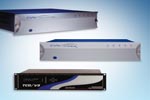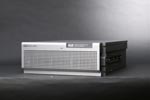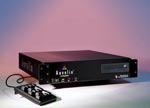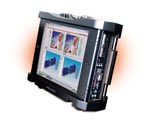- In a recent white paper I wrote, "Over the last decade, we as consumers have become an impatient lot. We are no longer content with passively sitting in front of the 'mass medium' we know as broadcast television beaming into our living rooms, helplessly staring at the messages being fed to us. The big three networks of NBC, CBS, and ABC have been supplanted by cable TV with 900 channels to meet our ever-changing viewing whims and every possible point of view. The growth of the 24-hour news channels gives us immediate news coverage and places us in the middle of important events as they unfurl. The key word here is immediate. We want immediate information wherever we are and further than that the ability to interact with what is being shown to us. Our 'demand' is for instant gratification whether it be fast food, ATMs, the ubiquitous cell phones, or the omni-present internet."
- The need for speed and instant availability of information is changing our world and how we interact with all of the environments that interconnect us. This paradigm shift in social priorities has an effect on each of us in our daily lives and permeates every industry, including the broadcast industry and the commercial AV integration industries, in a profound way.
- The changing patterns of communication are most evident in the use of cell phones, the internet, collaboration and conferencing, and the rapidly growing field of digital signage. According to InfoComm's 2006 Market Forecast Study, the three most significant areas of growth in the commercial AV industry over the next five years will be collaboration and conferencing, digital signage, and the migration of displays from 4:3 aspect ratios to 16:9.
- For those of us in the "biz" there is no hotter topic than digital signage.
- Finally the convergence of application, technologies, and price is taking place and we see the market exploding before our very eyes. Digital signage is much more diverse than the outside world may imagine. It includes applications in the corporate world, security, government, education, the religious market, and entertainment, but perhaps the highest-profile market niche is in retail environments. This brings us to most interesting phenomenon in the adoption and growth of digital signage. For the first time in more than 50 years we are seeing a fundamental change in advertising and the mediums in which advertising is "broadcast" to consumers. This change is what is driving the growth in digital signage in the retail community and even spilling over to the other applications of digital signage as well.
- We are clearly seeing a migration from broadcasting to narrowcasting as advertisers recognize the need to go where the proverbial action is. A classic example of this is the Wal-Mart TV "network" in thousands of its stores worldwide. In a single day, Wal-Mart reaches more customers via its network than all the traditional broadcast television channels combined. Wal-Mart and many other retail giants have taken advertising dollars and placed them where they can be most effective-going to where the customers actually are at any given point in time.
- You may not recognize just how important the shift in advertising expenditures is as it relates to digital signage acceptance as a mainstream medium. In fact, the shift in revenues from traditional broadcast to "spotcast" and narrowcast is proof positive that the market is migrating in this direction. Evidence of the trend to newer advertising mediums is reported by TNS Media Intelligence, a respected market analysis firm reporting on the advertising industry. Its research reports that in 2007 we will see a forecasted growth in the advertising expenditures of less than 3 percent. At first glance this may not be significant, until we look at recent history. In the year 2000 there was a 13.3 percent growth from the previous year. By 2004 the growth had cooled off to a 9.8 percent growth. Last year in 2006 they reported a 3.8 percent growth and for 2007 they expect a 2.6 percent growth in advertising expenditures.
- I looked deeper into the research and found some interesting trends that support the case for growth in the non-broadcast arenas. For 2007, TNS forecasts a 13.4 percent growth in internet advertising expenditures, a 6.6 percent growth in syndicated TV advertorials, and a 5.7 percent growth in outdoor advertising. In the area of network TV advertising they expect a 0.6 percent "growth" and in spot TV a -2.8 percent decline in ad expenditures. The data clearly shows a migration of advertising dollars away from broadcast and into the more targeted areas represented by all forms of digital signage.
- What this means to the digital signage industry is that there is tangible proof from sources outside of our own industry that shows the adverting industry is changing the vehicles which they use to transport their messages to the public. Furthermore, the advertising industry is expanding the breadth of the mediums that they use. From ads on cell phones, to the ubiquitous PC, to gas stations, convenience stores and shopping malls, we see messages popping up all around us. Our challenge is to make certain that those who create the ads for companies around the world clearly understand what we bring to the party and help them recognize the applications and locations of digital signage systems that will give them the most ROI and visibility for their intended customers. Digital signage is alive and well.
Media Server Products 2007
AMX's MAX-HT04
Specifically created to meld with the home theater, the MAX-HT04 from AMX can be visibly placed among other high-end electronics and is designed to blend into the demanding acoustics of the room. The MAX-HT04 allows you to efficiently store and manage up to 250 DVDs/5,300 CDs, with CDs stored instead of DVDs at a ratio of 25 to 1. If more storage is needed, the MAX-HT04 can be expanded in increments of four 400GB hard drives.
Sonic Foundry's Mediasite
Sonic Foundry has added new podcasting and automated scheduling capabilities to its Mediasite family of web communication solutions. The latest release includes Mediasite Podcast that automatically transforms any Mediasite presentation into portable audio content for on-the-go playback with Apple iPods, iTunes, or any other MP3 player. The release also provides for automated scheduling of presentation recordings by customers who create large libraries of recurring presentations, featuring the industry's first flexible start-stop functionality.

Doremi Labs' Nugget
Doremi Labs' Nugget is an affordable solution for high definition video playback. Its HD video is a perfect match for the new generation of video projectors, LCD, and plasma displays that feature native resolution far superior to NTSC and PAL video. The Nugget plays standard definition and HD video files up to 80Mbits/sec 4:2:2. Users can transfer popular video file formats to the Nugget's internal hard drive via Ethernet. The video clips can be played in their native resolution or at any supported output format.

Adtec Digital's Solist And edje 4111 HD
Adtec Digital's Soloist 4111 HD and edje 4111 HD digital media players boast MPEG 4 H.264, and MPEG 2 high definition and standard definition media playback. Regardless of the source, each device can automatically scale the content to match the output target up to 1080i60. Media can easily be loaded, managed, and scheduled for playout, utilizing the included mediaControl software with command interface and scheduler to play a list of files and loop indefinitely. The Soloist 4111 HD boasts the ability to tune into IPTV networks, decoding IP Multicast HD content with fall-back playout of stored content.

360 Systems' Image Server MAXX 6T
The Image Server MAXX video and graphics servers from 360 Systems are easier to implement as a result of the newly available Leightronix TCD/V3, a network-enabled device featuring an improved built-in user interface for automation scheduling and management. When used in tandem with the TCD/V3, users can create a network-based video content management and distribution infrastructure for control and play-out of up to 16 Image Servers or 48 direct-to-air channels.
Alcorn McBride's Digital Video Machine HD
Alcorn McBride's Digital Video Machine HD players support all ATSC formats at rates up to 50Mbps. They can also convert between formats on the fly, or perform enhanced 3:2 pull-down conversion on film-originated material encoded at 24p. Media can be updated via Ethernet or by swapping the removable hard drive. Unlike many high definition players, the DVM/HD can be synchronized to standard NTSC blackburst sync so multiple players--even in different formats-- always stay together.

Streambox's SBT3-7400 And SBT3-7100
The SBT3-7400 and SBT3-7100 systems enables users to stream up to six channels of audio and one channel of video from its full video production facility to and from smaller flight packs at other locations. Using these two systems, the systems provide real-time bidirectional streaming by "distributing" different parts of each service throughout its sites. The SBT3-7100 and SBT3-7400 systems are true 24/7 plug-and-connect, real-time video transport solutions that deliver full-motion, full-frame interlaced broadcast video and audio over IP-based networks. The core feature of the SBT3-7400 system is its full-duplex mode, which enables each unit to operate as an encoder and a decoder at the same time.

Electrosonic's MS9500-GL HD Player
Electrosonic Media Networks Division has introduced the MS9500GL, a networked high definition MPEG player for show replay, signage, and other AV applications. The MS9500GL offers the additional capabilities of genlock, timecode, and GPIO, providing truly synchronized multi-channel HD replay. For digital signage applications, the MS9500GL combines high definition video with still images, scrolling tickers and HTML pages for a vast array of display possibilities.

Avocent's EmergeT MPX1000 HD Multipoint Extender
The Avocent Emerge MPX1000 HD multipoint extender solution provides wired or wireless connectivity for moving high-definition content from a source to one or more destinations incorporating high-definition multimedia interface (HDMIT) technology. High-resolution VGA or HDMI/DVI computer graphics up to 1280 x 768 resolution, HD video including 720p, stereo audio, and control data are wirelessly transmitted to as many as eight wireless or wired receivers. The MPX1000 HD multipoint extender includes a transmitter and receiver that provide high-definition media support.

Grass Valley's K2 Media Server
Designed specifically for the sharing and reuse of digital media assets, the open-standards based Grass Valley K2 media server and media client system from Thomson delivers the high capacity, throughput, concurrency, and availability that media-driven environments demand, while maintaining the reliability, redundancy, and scalability for which customers demand. The result is a system that supports digital playout and distribution workflows, simplifies installation and operation, and provides new levels of network control.

MagicBox's Aavelin
MagicBox manufactures video messaging equipment for digital signage applications, and the Aavelin meets all digital signage and video messaging needs. Standard Aavelin features include comprehensive scheduling, Macromedia Flash support, use of any True Type Font, and four independent crawl/overlay regions. All units are IP addressable. Available options include picture-in-picture, remote emergency access, DVD/VHS/MPEG playback, weather and forecasts, RSS data feeds, and a database integration tool called EZ Stream.
